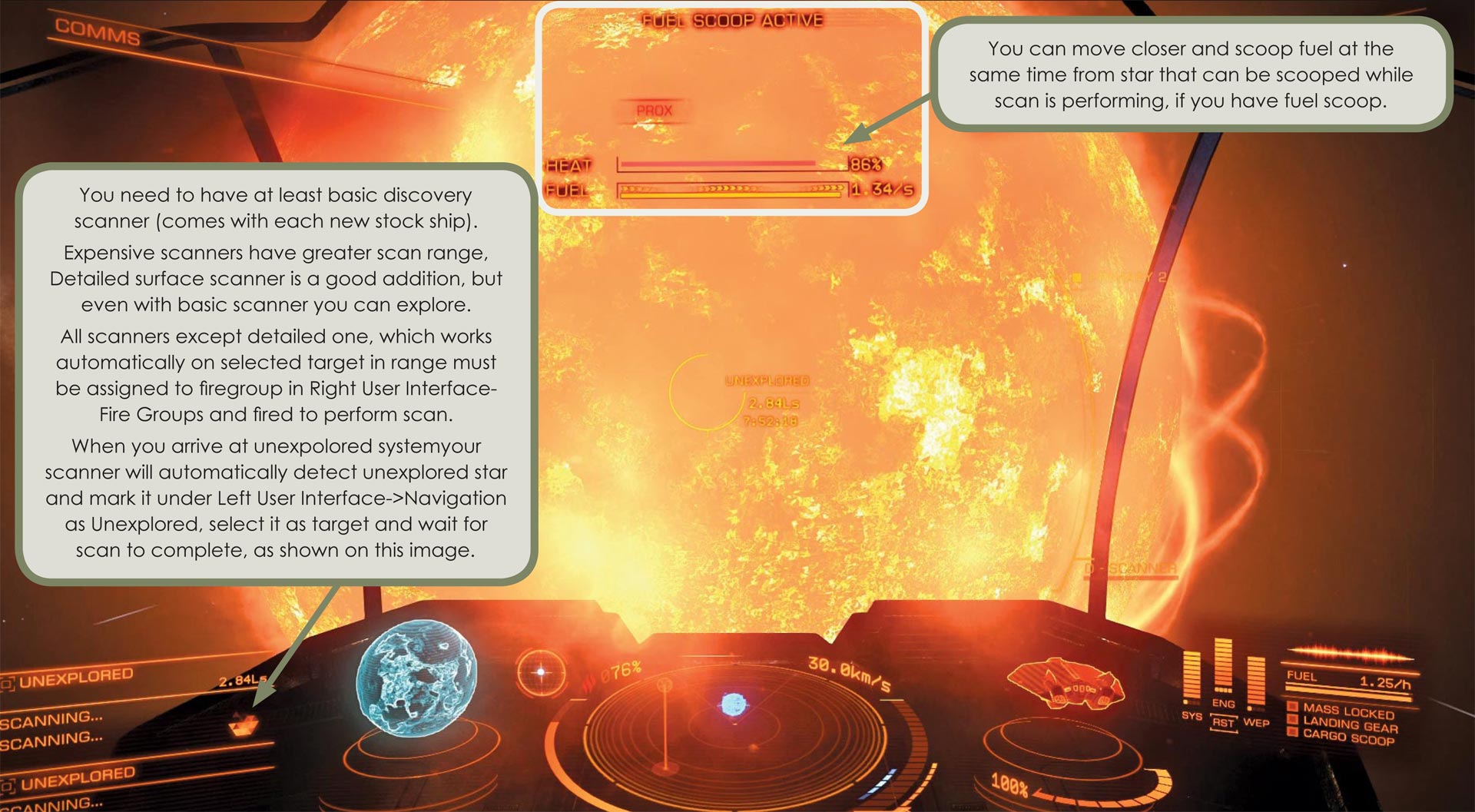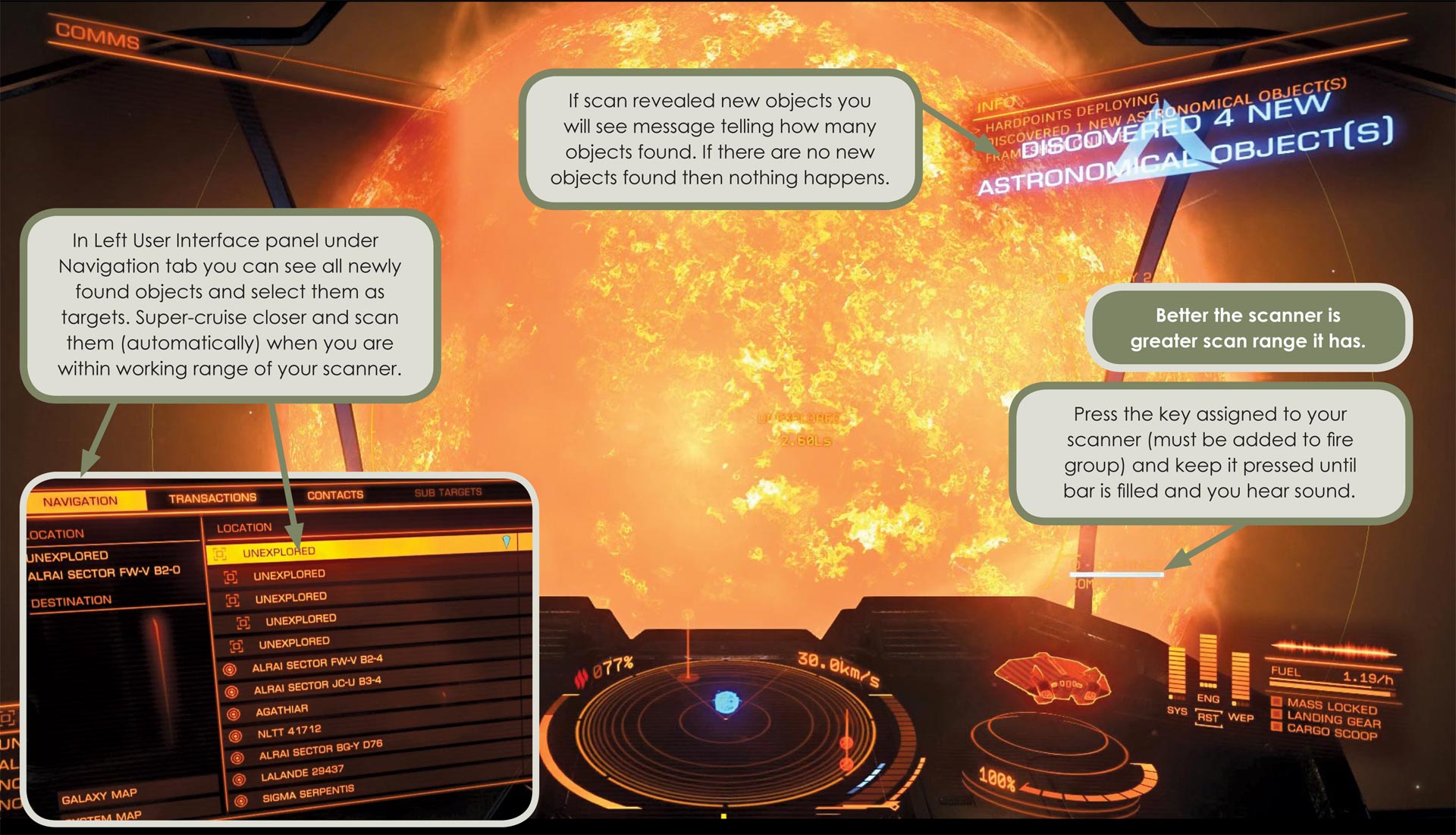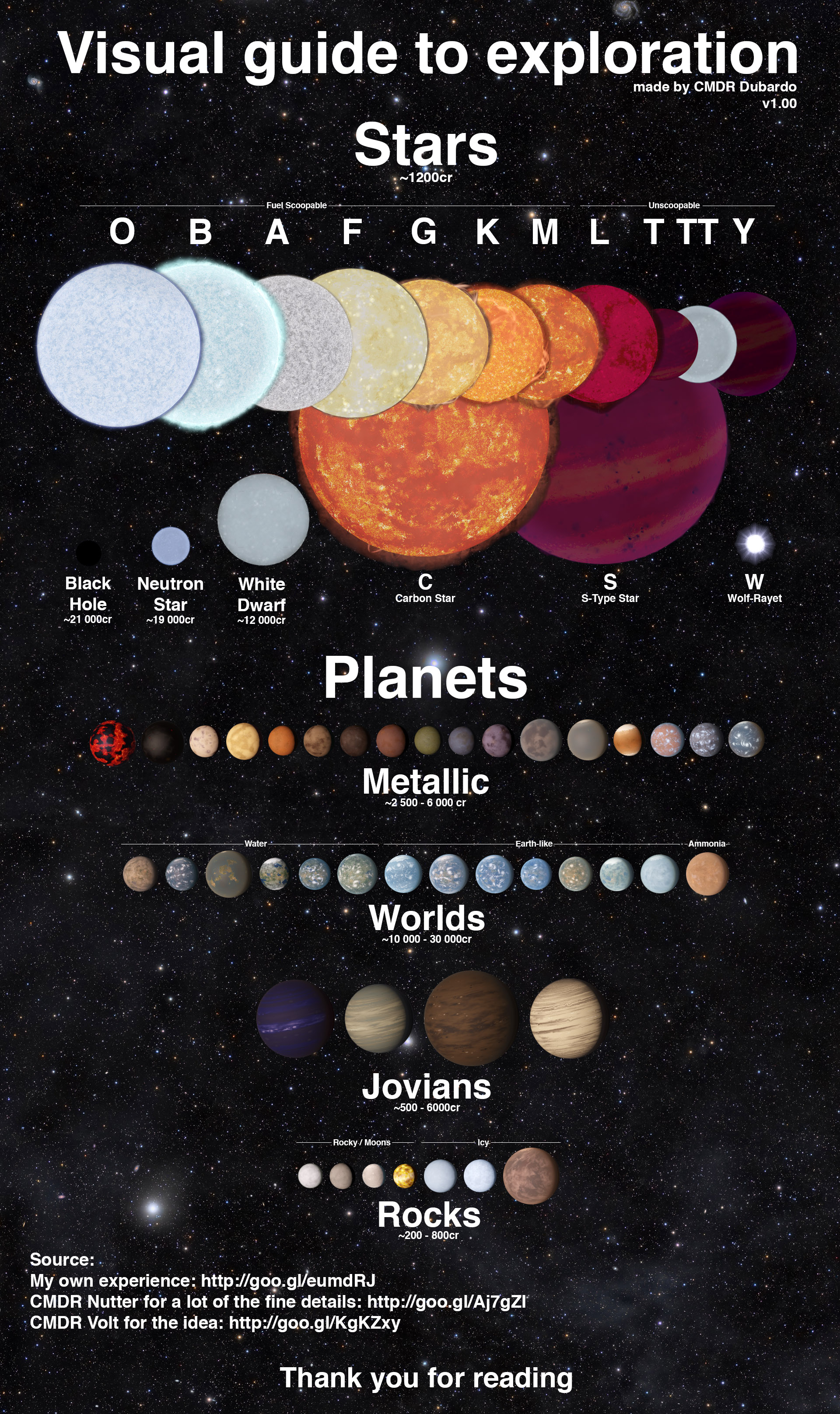
Elite Dangerous: Exploration
Video
Examples
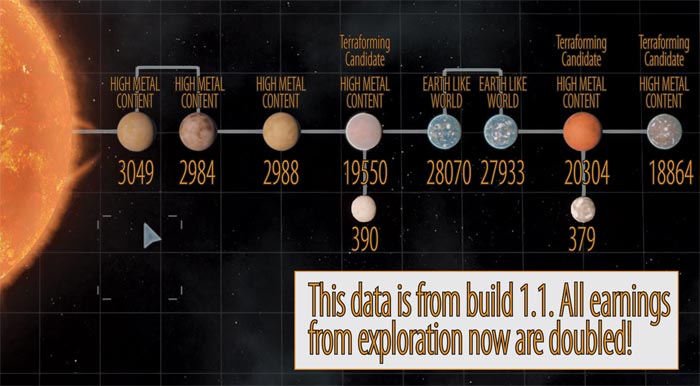
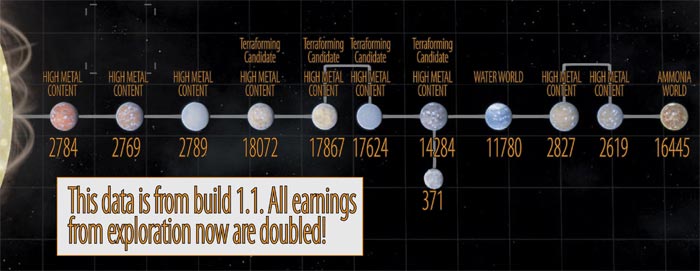
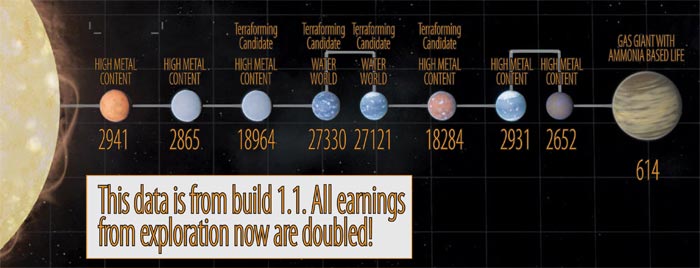
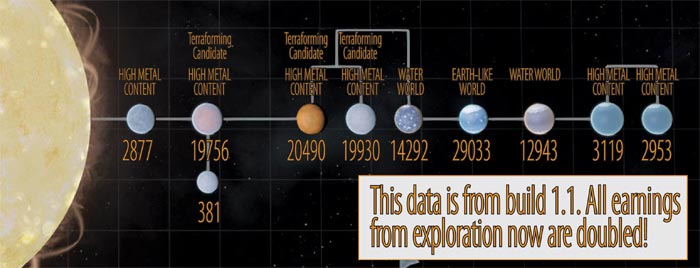
Visual guide
| Profit required for Exploration Ranks (from 1.2) | |
|---|---|
| Aimless | 0 |
| Mostly Aimless | 10,000 |
| Scout | 184,141 |
| Surveyor | 500,000 |
| Trailblazer | 1,100,000 |
| Pathfinder | 4,491,000 |
| Ranger | 12,000,000 |
| Pioneer | 51,800,000 |
| Elite | 157,500,000 |
Introduction
When you first enter a system, make sure to lock onto the primary star and check to see if *it* has an orbital path. If so, then when flying around to seek out planets and distant companion stars, keep that lock, as the orbit path should help give clues about where to search. It's not a precise science, but it will help a lot.
Pick a system, any system from the map then select it's system view, if it has a bunch of unknown suns and no planets chances are you don't have data for it which could mean it's for sale on nearby stations, the further towards the edges of the playable area, the greater the chance those systems arent available for sale to nearby stations and haven't been scanned by other players. but the only way you know for sure is after scanning it you need to be the first one to sell that data for the fat payouts otherwise the data will be worth only a few hundred credits.
The discovery scanner needs to be activated by going to your right hand panel (systems) and then the Fire Groups tab, then you can set it to secondary fire. Then you hold down the secondary fire button until it is complete 5 or 6 seconds.
To "lock" onto a planet, you face it and target it if it says it is unknown, get closer to it. Once you get within a certain range (this seems to widely change from 120Ls to 5Ls) the target panel will change to say scanning. Keep pointed at the planet until it is finished.
Exploration 001
I've been "exploring" the mechanics of exploring (), and have a few details that I have figured out to share:
– unexplored planets to do not show up on system map, nor are their orbits marked out, until discovered
– the Basic system scanner is used by assigning it to a weapon group. you can select the group and "fire" the scanner in supercruise.
– what the basic scanner does is "look around" your current location (its non directional) for nearby stellar objects, and adds them to your navigation list as "[unknown]"locations that you can now lock onto. lining up manually and getting close enough will mark it as [unknown] as well, so the basic scanner is more of a helper, or a "dangit! i lost it in a flyby" re–finder
– depending on the size of the unknown object, the range that the targeting scanner begins to scan it varies (ive found 15–50 Ls). Its automatic when close enough, and acts like a ship initial scan on the lower left hud, though takes longer to complete.
– you can find distant objects outside of your basic scanner ranges by going fast in superCruise, and looking for "anomalous motion" in the starfield as you spin and circle around. This motion is a "star" that moves around the background sky. This pinpoint of light is a planet. Go get it!
– if you replace the basic scanner with a Detailed Surface Scanner, thinking that it is an upgraded part, you are mistaken. The Detailed surface scanner is an upgrade to your targeted information scanner. The Basic Discovery Scanner is used differently, to sweep the area for unknown objects, to make them target–able. You may still replace it, but then have to discover objects with the anomalous motion method, and manual alignment and approach, and deceleration (the hard[er] way)
– the Detailed surface scanner can replace the cargo rack on a sidewinder (it goes in that sort of internal slot), while it could also fill the shield slot, I dont recommend it.
– the Detailed Surface scanner is bugged: if you scan down a planet with one installed, the scan result will read "unknown" still. That is the extent of the bug; the data is there (in the system map), and the scan was successful, and can be sold at a station.
– Selling at a cartographic part of a station can be found by scrolling to the bottom of listed buy options
– selling scan data for a planet is worth X [a variable based on value of world discovered: earth like is presumably more valuable than icy gas giant], using nothing but the base equipment. the addition of the Detailed Surface Scanner increases the profit by [undetermined] amount
– buying exploration data simply downloads the current explored scan results of other players. If you have more detailed scanning equipment (the detailed surface scanner, to date), than the original scan used, you can go get additional scan details for $$, but will now be unable to earn money by finding it yourself.
– yes, the same planet can be scanned over and over by hundreds of players, and still pay out. But be the FIRST to sell something, you get a bigger chunk
The Faction you sell to grants you +rep for that faction. higher Rep equates to cheaper prices and larger payouts [presumably at this point]
More about exploration
– My guess is that before exploring a system, the system map shows you the stars that are known about – I think of it as this is what the Hubble telescope showed us before we got there, and is what is in the ships database
– When I get into a system that is occupied by platforms/station they are shown on the system map because they are broadcasting a signal. Having received that the ships database adds them. It is not so strange they are in systems with unknown stars because they are only unknown to your ship
– before visiting some systems you can tell whether there is/are planet/s if you see a grey line coming out of one of the suns. This may affect your choice of whether you will make more money surveying that rather than going to a sun only system
– I'm guessing that the developers have not set up one or two systems properly. And so you see lines not attached to anything in the system map
– after entering a system I do a quick scan pressing fire on the fire group to which the scanner is allocated in order to find nearby objects. I then fly out a way, turn round a target the principal star/sun in the system to name it after a few seconds of scanning. That will give you it's orbit path (yellow line)
– fly out to the orbit line and then reverse course to the opposite orbit line in order to travel in the plane of the orbit, occasionally hitting scan. By the time I get to the opposite line I'm going very fast and that is a great help in showing relative motion of distant objects
– often you can see an obvious group of bright things or a sun on the plane
– hit the scan button often
– mostly I've found the additional suns are located on the same plane as the principal stars orbit. But once or twice Iv'e turned at right angles to the orbital plane to search successfully
– travelling fast I change direction laterally, (using only the keyboard left/right keys because if I use the joystick it's too easy to move up or down slightly) to orbit the principal outside of its plane. I keep the yellow orbit line visible from the left window, and then look for relative movement in the star field. Mostly it's fairly obvious but it's necessary to go pretty far out sometimes to find the most distant. And very high speed becomes very necessary
– because I am travelling in parallel, and in the plane of the system principal, then anything out there should be moving against the background. For difficult ones I point outward more and switch my view to the left side window as well, so I can see the yellow line
– if you are in doubt whether you are going the right way, look at your speed. After you get half way to the distant spot your speed will start to decay, and confirms you are heading towards another mass. Strange that the game does this as you would expect the gravitational pull to increase your speed. But it's a handy dodge. Fastest I have been so far before the speed started to decay was about 850c
– sometimes a second sun can be orbiting so close to the first that it is masked. Look at the first very closely occasionally to make sure it is perfectly circular
– after todays server patch it all seems to be working better eg. targeting, less unknowns
– dont go close to or scan unknowns unless they are earth like in the system map. At the moment there is a bug in cartography, and you get less dosh after getting details on barren objects. Do a detailed scan of earth likes and then cash in. Go back and identify the remaining planets for more cash
– it can take 20 minutes at top speed to reach some objects if you are lucky enough to spot them that far away
– there are intermediate and advanced scanners available now if you can find them. The intermediate makes life a bit easier but is expensive at half a million
– if there are platforms/stations on the map then there will be planets near them. If you can't work out whether they are in front or behind the planet note their distance and align on the planet for it's distance and you can see which is furthest. Handy as if you get to close to a planet you can find your speed really nerfed
– the scanner must be allocated to a fire group in order to 'fire' it. The surface scanner works with the other scanner and is auto – it does not have to be fired
– if actuating the scanner causes warnings, oxygen loss etc, then go into modules and turn things off until you are only using 100% of power or less – probably the weapons if you can bare to. Get a bigger engine and power distribution

